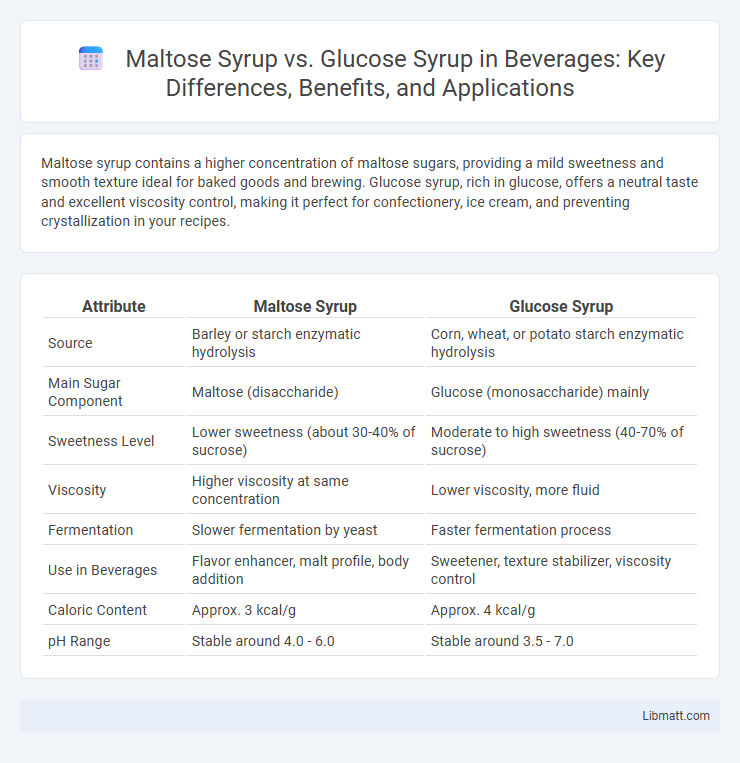Maltose syrup contains a higher concentration of maltose sugars, providing a mild sweetness and smooth texture ideal for baked goods and brewing. Glucose syrup, rich in glucose, offers a neutral taste and excellent viscosity control, making it perfect for confectionery, ice cream, and preventing crystallization in your recipes.
Table of Comparison
| Attribute | Maltose Syrup | Glucose Syrup |
|---|---|---|
| Source | Barley or starch enzymatic hydrolysis | Corn, wheat, or potato starch enzymatic hydrolysis |
| Main Sugar Component | Maltose (disaccharide) | Glucose (monosaccharide) mainly |
| Sweetness Level | Lower sweetness (about 30-40% of sucrose) | Moderate to high sweetness (40-70% of sucrose) |
| Viscosity | Higher viscosity at same concentration | Lower viscosity, more fluid |
| Fermentation | Slower fermentation by yeast | Faster fermentation process |
| Use in Beverages | Flavor enhancer, malt profile, body addition | Sweetener, texture stabilizer, viscosity control |
| Caloric Content | Approx. 3 kcal/g | Approx. 4 kcal/g |
| pH Range | Stable around 4.0 - 6.0 | Stable around 3.5 - 7.0 |
Understanding Maltose Syrup: Composition and Production
Maltose syrup is primarily composed of maltose, a disaccharide made of two glucose molecules linked together, produced through the enzymatic hydrolysis of starches such as barley or corn. The production process involves breaking down starches with enzymes like amylase, resulting in a syrup with a mild sweetness and excellent fermentable sugar content. Understanding the composition and production of maltose syrup helps you choose the right ingredient for applications requiring specific sweetness levels and fermentation properties.
What is Glucose Syrup? Key Properties and Sources
Glucose syrup is a viscous liquid derived primarily from the hydrolysis of starches such as corn, wheat, or potatoes, containing varying proportions of glucose, maltose, and higher saccharides. Its key properties include a high sweetness level, excellent solubility, and the ability to prevent crystallization in confectionery and baked goods. Widely used in food manufacturing, glucose syrup serves as a humectant, thickener, and fermentable carbohydrate source, distinguishing it from maltose syrup, which has a higher maltose content and different sweetness and functional profiles.
Comparison of Maltose and Glucose Syrup: Chemical Structure
Maltose syrup consists primarily of maltose, a disaccharide composed of two glucose units linked by an a(1-4) bond, while glucose syrup contains a mixture of glucose, maltose, and higher oligosaccharides derived from starch hydrolysis. The molecular structure of maltose syrup results in a sweeter taste and slower digestibility compared to glucose syrup, which has a higher concentration of monosaccharide glucose molecules that provide rapid energy release. Understanding these chemical differences can help you choose the appropriate syrup based on desired sweetness, viscosity, and metabolic effects.
Sweetness Levels: Maltose Syrup vs Glucose Syrup
Maltose syrup typically exhibits a sweetness level around 30-50% relative to sucrose, making it less sweet than glucose syrup, which generally ranges from 70-80% sweetness compared to sucrose. The lower sweetness of maltose syrup makes it suitable for products requiring mild sweetness and enhanced texture without overpowering flavor. Glucose syrup's higher sweetness and viscosity contribute to its widespread use in confectionery and baked goods for sweetness and moisture retention.
Functional Uses in Food Manufacturing
Maltose syrup, rich in disaccharides, enhances browning and provides a mild sweetness in baked goods and confectionery, improving texture and shelf-life. Glucose syrup, high in glucose content, serves as a thickening agent, humectant, and crystallization inhibitor, ensuring smooth texture in candies, ice creams, and beverages. Both syrups play crucial roles in controlling viscosity and moisture retention, optimizing the consistency and stability of diverse food products.
Texture and Viscosity Differences
Maltose syrup features a thicker texture and higher viscosity compared to glucose syrup, making it ideal for recipes requiring a chewier consistency. Glucose syrup exhibits a smoother, more fluid texture due to its lower viscosity, enhancing your ability to create glossy finishes and prevent crystallization in confections. Understanding these differences helps you select the right syrup for desired mouthfeel and processing characteristics.
Health Impacts and Nutritional Value
Maltose syrup contains a higher concentration of maltose, which breaks down slower than glucose, leading to a more gradual increase in blood sugar levels and potentially better for sustained energy release. Glucose syrup, rich in glucose, results in a rapid spike in blood sugar, which may contribute to insulin resistance and increased risk of metabolic disorders if consumed in excess. Nutritionally, maltose syrup provides moderate calories with a slower glycemic response, while glucose syrup offers quick energy but lacks significant vitamins or minerals, impacting overall health differently based on consumption patterns.
Applications in Baking and Confectionery
Maltose syrup enhances baking and confectionery by providing a mild sweetness and improving moisture retention, resulting in softer textures and longer shelf life in products like cookies and cakes. Glucose syrup, with its higher sweetness and viscosity, is ideal for creating smooth, chewy textures in candies and preventing sugar crystallization in frostings and fillings. Your choice between maltose and glucose syrup depends on the desired sweetness level and texture characteristics in your baked or confectionery goods.
Cost and Availability: Market Considerations
Maltose syrup generally has a higher cost than glucose syrup due to its more complex production process and limited raw material sources. Glucose syrup benefits from widespread availability and lower prices, as it is produced from abundant starch sources like corn and wheat. Market demand favors glucose syrup for large-scale food manufacturing because of its cost-effectiveness and consistent supply chain.
Choosing the Right Syrup: Industry Recommendations
Industry recommendations emphasize selecting maltose syrup for products requiring a mild sweetness and superior viscosity, such as confectionery and brewing. Glucose syrup is preferred in bakery and ice cream industries for its high sweetness, solubility, and ability to inhibit crystallization. Manufacturers prioritize syrup choice based on desired texture, sweetness level, and functional properties to optimize product quality and shelf life.
Maltose syrup vs glucose syrup Infographic

 libmatt.com
libmatt.com